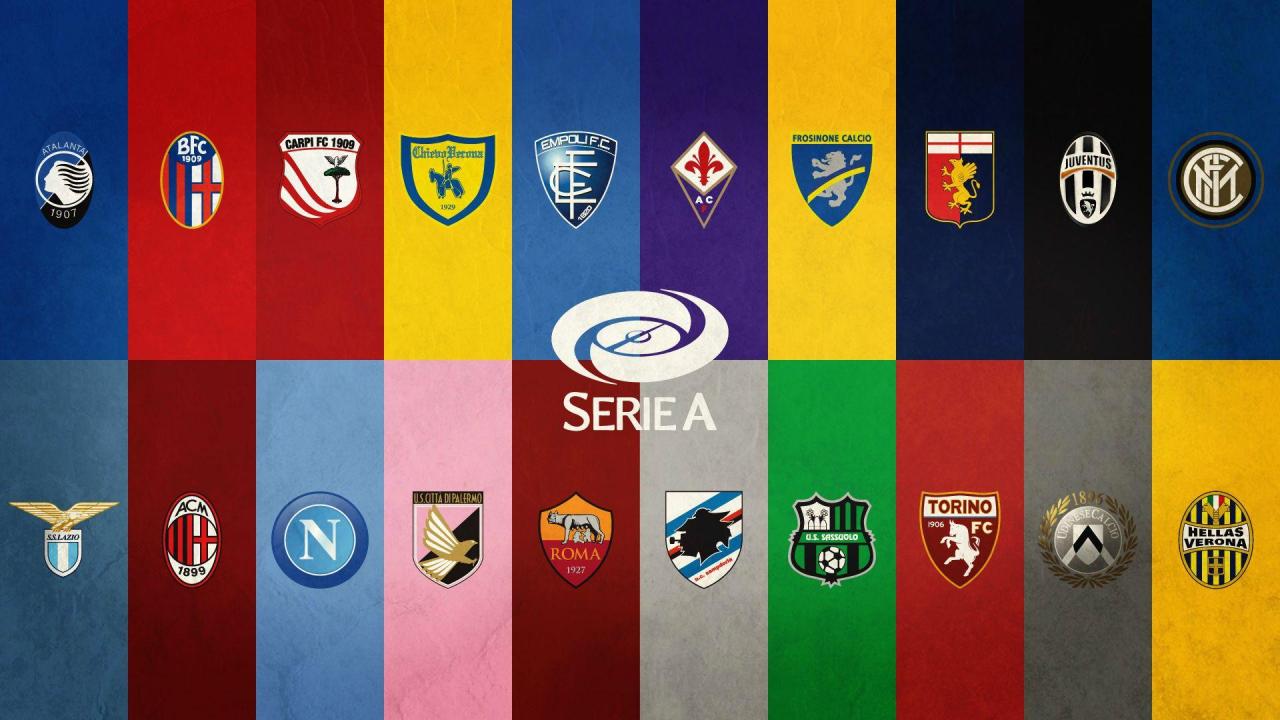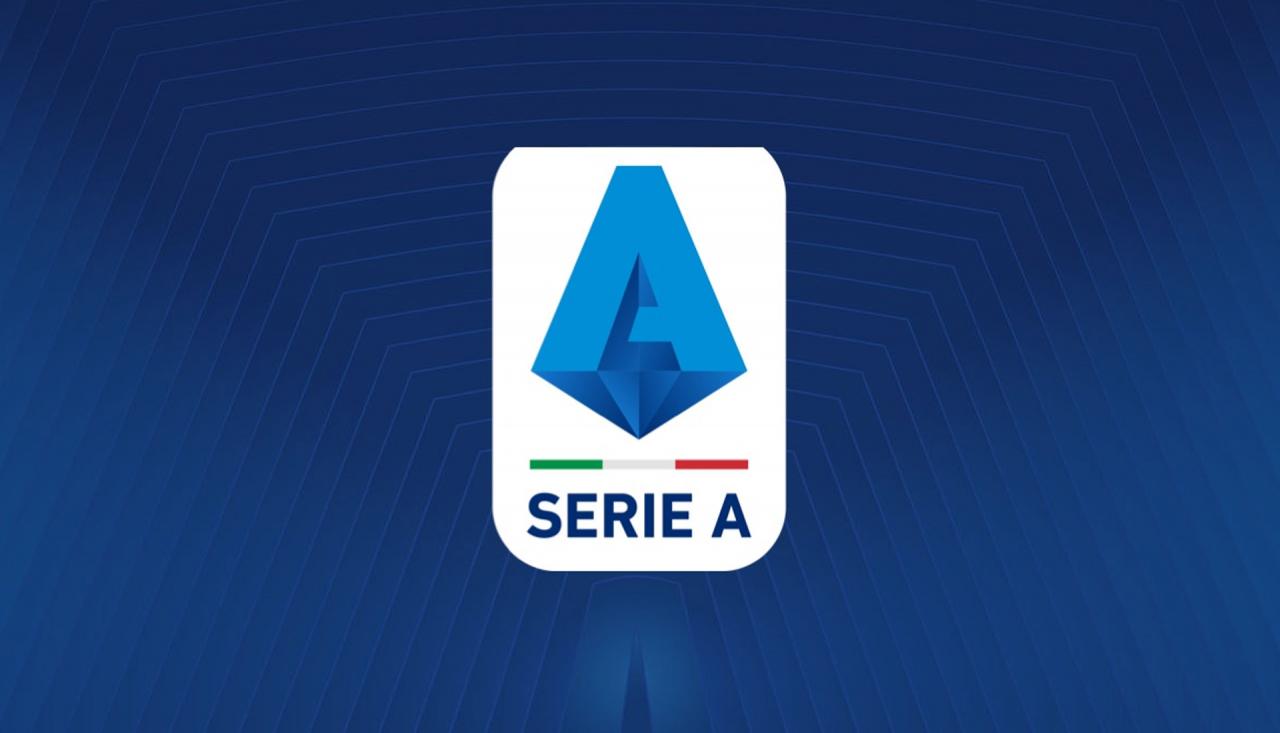Serie A, the pinnacle of Italian football, has captivated audiences for decades with its captivating matches, legendary players, and passionate fan base. From its storied history to its current-day stars, Serie A continues to enthrall fans worldwide.
The league’s current season promises thrilling contests, with top teams vying for the coveted Scudetto. Players showcase their extraordinary skills, while tactical battles unfold on the pitch, leaving fans on the edge of their seats.
Overview of Serie A
Serie A, known as the Italian Football Championship, is the top-tier professional football league in Italy. Established in 1898, it is one of the most prestigious and competitive football leagues globally, boasting a rich history and iconic clubs.With 20 teams competing in a double round-robin format, Serie A has witnessed the dominance of legendary clubs like Juventus, AC Milan, and Inter Milan.
The league has produced numerous world-class players and has been a significant contributor to the development of football tactics and strategies.
Current Season Analysis
The 2022-23 Serie A season is underway, with some of the most renowned teams in Europe vying for the coveted title. Napoli, AC Milan, Inter Milan, and Juventus are considered the favorites, and their performances have lived up to expectations.
Napoli, led by manager Luciano Spalletti, has been in exceptional form, dominating the league table with a series of impressive victories. Their attacking trio of Khvicha Kvaratskhelia, Victor Osimhen, and Hirving Lozano has been particularly lethal, scoring crucial goals and creating numerous chances.
AC Milan, the defending champions, have also started the season strongly. Under the guidance of Stefano Pioli, they have maintained their attacking flair while improving their defensive solidity. Rafael Leao, Olivier Giroud, and Theo Hernandez have been key contributors to their success.
Top Players, Serie A
Several players have stood out for their exceptional performances this season. Khvicha Kvaratshelia has emerged as a genuine star for Napoli, showcasing his dribbling skills, creativity, and goalscoring ability. Victor Osimhen has been equally impressive, using his physical prowess and clinical finishing to terrorize opposing defenses.
For AC Milan, Rafael Leao has continued to shine, providing pace, skill, and goals from the left flank. Olivier Giroud has proven his worth as a reliable target man, scoring crucial goals and linking up effectively with his teammates.
Team Strategies
Napoli’s success can be attributed to their high-pressing, possession-based style of play. They dominate possession and create numerous chances through quick passing and incisive movement. AC Milan, on the other hand, has adopted a more balanced approach, combining attacking flair with defensive stability.
Inter Milan, under the leadership of Simone Inzaghi, has favored a 3-5-2 formation, which has allowed them to control the midfield and create chances for their attacking duo of Lautaro Martinez and Romelu Lukaku. Juventus, managed by Massimiliano Allegri, has opted for a more pragmatic approach, focusing on defensive solidity and relying on individual moments of brilliance from players like Dusan Vlahovic and Angel Di Maria.
Historical Rivalries

Serie A has witnessed several iconic rivalries throughout its history, with intense matches, passionate fan bases, and unforgettable moments.
The Trump jury is currently deliberating the fate of former President Donald Trump, who is facing charges of inciting an insurrection on January 6, 2021. The jury is made up of 12 people, six men and six women, who were selected from a pool of hundreds of potential jurors.
The origins of these rivalries often lie in geographical proximity, cultural differences, or historical events. Over the years, they have become deeply ingrained in Italian football culture, shaping the league’s narrative and creating an electrifying atmosphere on match days.
Juventus vs. Torino
Known as the “Derby della Mole,” this rivalry is one of the oldest and most passionate in Serie A. The two clubs are based in Turin, just a few kilometers apart, and represent different parts of the city. Juventus is associated with the wealthy industrial north, while Torino is rooted in the working-class south.
The first match between the two teams was played in 1906, and since then, the rivalry has been marked by intense competition, controversial incidents, and memorable matches.
Milan vs. Inter Milan
Also known as the “Derby della Madonnina,” this rivalry is between the two most successful clubs in Italian football history. Both teams are based in Milan, and their rivalry dates back to the early 20th century.
Milan represents the more traditional and aristocratic side of the city, while Inter is associated with the working-class immigrant population. The rivalry has been fueled by on-field clashes, off-field controversies, and a fierce competition for silverware.
Roma vs. Lazio
Known as the “Derby della Capitale,” this rivalry is between the two major clubs in Rome. Roma is associated with the city’s working-class neighborhoods, while Lazio is rooted in the more affluent areas.
The rivalry began in the 1920s and has been characterized by passionate fan bases, intense matches, and controversial incidents. Both teams have a large and vocal following, and their matches often draw massive crowds.
Napoli vs. Roma
Known as the “Derby del Sole,” this rivalry is between two of the most passionate fan bases in Serie A. Napoli represents the southern Italian city of Naples, while Roma represents the capital city of Rome.
The rivalry has its roots in historical and cultural differences between the two regions. Matches between Napoli and Roma are often characterized by a vibrant atmosphere, colorful tifos, and intense competition.
Cultural Impact
Serie A holds a profound place in Italian culture, serving as a unifier and a source of national pride. Football is deeply ingrained in Italian society, with Serie A matches drawing immense attention and passion from fans across the country.
Fan Culture and Traditions
Italian football fans are renowned for their unwavering support and passionate displays of devotion. Stadiums are often filled to capacity, with vibrant colors, banners, and chants creating an electrifying atmosphere. Fans engage in lively debates and discussions about their favorite teams, fostering a sense of community and belonging.
The “tifosi,” as they are called, express their love for their clubs through elaborate choreographies, songs, and pyrotechnic displays, creating a captivating spectacle that transcends the game itself.
Global Reach
Serie A has been steadily expanding its global reach in recent years, becoming one of the most watched and followed football leagues in the world. The league’s popularity has soared beyond Italy’s borders, captivating fans from all corners of the globe.
To cater to its growing international audience, Serie A has implemented a series of strategies. These include broadcasting matches in multiple languages, establishing partnerships with international broadcasters, and investing in digital platforms to engage with fans worldwide.
The Trump jury has been the subject of intense scrutiny, with many questioning its impartiality. The jury is composed of 12 individuals who were selected from a pool of 250 potential jurors. The selection process was overseen by a judge, who made the final decision on who would serve on the jury.
Key Strategies
- Broadcasting matches in multiple languages, including English, Spanish, Arabic, and Chinese, to reach a wider audience.
- Partnering with international broadcasters, such as ESPN, Fox Sports, and Sky Sports, to distribute matches to viewers in over 200 countries.
- Investing in digital platforms, including the Serie A website and mobile app, to provide fans with real-time updates, match highlights, and exclusive content.
- Hosting pre-season tours in different regions of the world, such as the United States, Asia, and Australia, to promote the league and connect with fans.
These strategies have been instrumental in increasing Serie A’s global appeal, making it one of the most recognized and followed football leagues in the world.
Financial Landscape

Serie A operates under a complex financial structure, influenced by various factors such as television rights, sponsorship deals, and club ownership models. Revenue streams for Serie A clubs primarily include:
-
-*Television Rights
A significant portion of Serie A’s revenue comes from the sale of television rights to domestic and international broadcasters. The league has lucrative contracts with major broadcasters, ensuring a steady stream of income for clubs.
-*Sponsorship Deals
Serie A clubs also generate revenue through sponsorship agreements with a range of companies. These deals provide clubs with financial support and increase their visibility.
-*Matchday Revenue
Ticket sales and other matchday-related income contribute to the financial health of Serie A clubs. However, matchday revenue is typically a smaller component of overall revenue compared to television rights and sponsorship deals.
Spending patterns in Serie A vary depending on club ownership models and financial strategies. Some clubs, such as Juventus and Inter Milan, have historically spent heavily on player acquisitions and wages, while others have adopted more conservative spending approaches.
Revenue Distribution
Revenue distribution in Serie A is determined by a combination of factors, including:
-
-*Historical Performance
Clubs that have performed well in recent seasons receive a larger share of revenue.
-*Popularity
Clubs with a larger fan base and higher television ratings receive a higher percentage of revenue.
-*Equalization Payments
A portion of revenue is distributed equally among all Serie A clubs to promote financial stability.
This revenue distribution system aims to ensure that all clubs have a fair chance of competing, regardless of their financial resources.
Player Profiles: Serie A
Serie A is renowned for showcasing some of the world’s most talented footballers. These players captivate fans with their exceptional skills, athleticism, and passion for the game. Here’s a closer look at some of the top players who have graced the Italian league in recent years:
These players have not only dominated Serie A but have also left an indelible mark on the international football landscape. Their performances have inspired countless aspiring footballers and continue to enthrall fans worldwide.
Cristiano Ronaldo
- Club:Juventus
- Position:Forward
- Key Stats:101 goals in 134 Serie A appearances, 5 Ballon d’Or awards, 5 Champions League titles
- Career Highlights:Led Juventus to two Serie A titles and one Coppa Italia; Won the Champions League with Real Madrid and Manchester United
Romelu Lukaku
- Club:Inter Milan
- Position:Forward
- Key Stats:64 goals in 95 Serie A appearances, 2 Serie A Golden Boot awards
- Career Highlights:Led Inter Milan to their first Serie A title in 11 years; Won the Premier League with Chelsea
Paulo Dybala
- Club:Juventus
- Position:Forward
- Key Stats:115 goals in 293 Serie A appearances, 5 Serie A titles
- Career Highlights:Won five Serie A titles with Juventus; Scored the winning goal in the 2020 Coppa Italia final
Team Profiles

Serie A is home to some of the most iconic and successful clubs in world football. Here are profiles of the top teams in the league:
Juventus
- History:Founded in 1897, Juventus is the most successful club in Italian history, with 36 Serie A titles.
- Stadium:Allianz Stadium (capacity: 41,507)
- Key players:Dusan Vlahovic, Angel Di Maria, Federico Chiesa
AC Milan
- History:Founded in 1899, AC Milan is one of the most successful clubs in the world, with 19 Serie A titles and 7 European Cups.
- Stadium:San Siro (capacity: 80,018)
- Key players:Rafael Leao, Olivier Giroud, Theo Hernandez
Inter Milan
- History:Founded in 1908, Inter Milan is another one of the most successful clubs in Italian history, with 19 Serie A titles.
- Stadium:San Siro (capacity: 80,018)
- Key players:Lautaro Martinez, Nicolo Barella, Alessandro Bastoni
AS Roma
- History:Founded in 1927, AS Roma is one of the most popular clubs in Italy, with 3 Serie A titles.
- Stadium:Stadio Olimpico (capacity: 72,698)
- Key players:Paulo Dybala, Lorenzo Pellegrini, Tammy Abraham
Napoli
- History:Founded in 1926, Napoli is one of the most exciting teams in Serie A, with 2 Serie A titles.
- Stadium:Stadio Diego Armando Maradona (capacity: 54,726)
- Key players:Khvicha Kvaratskhelia, Victor Osimhen, Andre-Frank Zambo Anguissa
Historical Moments
Serie A, Italy’s premier football league, has witnessed countless iconic moments throughout its storied history. From legendary matches to unforgettable players and groundbreaking events, the league has played a pivotal role in shaping the sport’s global landscape.
A timeline of some of the most significant moments in Serie A history:
Juventus’ Dominance
- 1931: Juventus wins its first Serie A title, beginning a period of dominance that would last for decades.
- 1950s: The “Golden Age” of Juventus, with stars like Giampiero Boniperti and John Charles leading the team to five consecutive titles.
- 1970s: Juventus establishes itself as the most successful club in Italy, winning nine titles in 11 seasons.
The “Miracle of Bern”
In 1954, Italy’s national team shocked the world by winning the FIFA World Cup in Switzerland. This unexpected triumph, known as the “Miracle of Bern,” was a defining moment in Italian football history and helped to restore national pride after World War II.
The Emergence of AC Milan
- 1958: AC Milan signs Brazilian legend Pelé, who becomes one of the greatest players in the club’s history.
- 1963: Milan wins its first European Cup, the forerunner to the UEFA Champions League.
- 1980s and 1990s: Under legendary coach Arrigo Sacchi, Milan becomes a global powerhouse, winning multiple Serie A titles and European Cups.
The Calciopoli Scandal
In 2006, a match-fixing scandal rocked Italian football, leading to the relegation of Juventus to Serie B. This major setback for the league tarnished its reputation but also served as a catalyst for reforms to improve transparency and accountability.
The Rise of Inter Milan
- 2008: Inter Milan, led by José Mourinho, wins the treble of Serie A, the Coppa Italia, and the UEFA Champions League.
- 2010s: Inter establishes itself as a major force in Italian football, winning five consecutive Serie A titles.
Future Outlook
Serie A faces several challenges and opportunities in the coming years. The league must address declining attendances, increasing competition from other European leagues, and the need to improve its financial stability. However, Serie A also has a number of strengths, including its passionate fan base, rich history, and iconic clubs.
If the league can capitalize on these strengths and overcome its challenges, it has the potential to remain one of the top football leagues in the world.
Financial Landscape
One of the biggest challenges facing Serie A is its financial instability. Many clubs in the league are struggling to make a profit, and some have even gone bankrupt in recent years. This has led to a decline in investment in players and infrastructure, which has made it difficult for Serie A to compete with other European leagues.To
address this issue, Serie A has implemented a number of financial regulations in recent years. These regulations are designed to help clubs reduce their debt and improve their financial stability. However, it remains to be seen whether these regulations will be effective in the long term.
Global Reach
Another challenge facing Serie A is its declining global reach. In recent years, other European leagues, such as the Premier League and La Liga, have become more popular around the world. This has led to a decline in Serie A’s television revenue and sponsorship deals.To
address this issue, Serie A has launched a number of initiatives to increase its global reach. These initiatives include investing in digital media, expanding into new markets, and signing partnerships with international clubs. However, it remains to be seen whether these initiatives will be successful in the long term.
Concluding Remarks
Serie A’s legacy extends beyond the boundaries of the pitch, deeply ingrained in Italian culture. It fosters a sense of community, ignites emotions, and shapes national identity. As the league continues to evolve, it remains a testament to the enduring passion for football in Italy and beyond.


